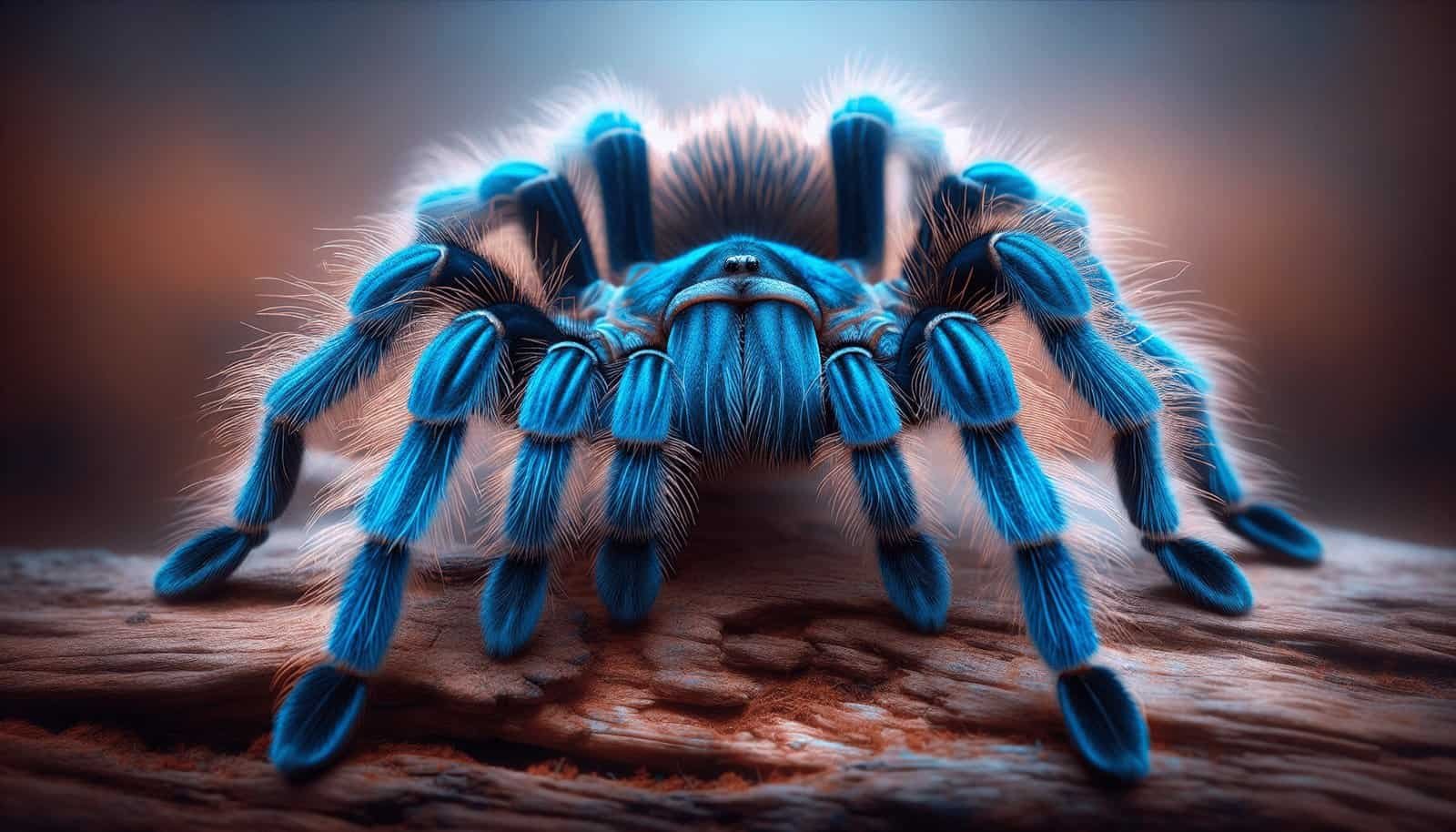If you’ve ever been mesmerized by the vibrant hues of the cobalt blue tarantula and wondered how this stunning spider grows and ages, you’re in the right place. In this article, you’ll discover the fascinating details about the lifespan and growth rate of this visually striking arachnid. From the early stages of its life to its full, breathtaking adult form, we cover how long these unique tarantulas live and the unique stages of their development. Dive in and learn more about these extraordinary spiders that capture the imagination with their brilliant cobalt blue coloration.
What Is The Lifespan And Growth Rate Of The Visually Striking Cobalt Blue Tarantula?
Have you ever wondered about the lifespan and growth rate of the visually striking cobalt blue tarantula? This fascinating arachnid, with its dazzling blue coloration, has captivated the interest of many enthusiasts and researchers alike. Whether you’re a seasoned arachnophile or a curious beginner, understanding the lifecycle and development of this amazing creature is both intriguing and important for proper care.

Introduction to the Cobalt Blue Tarantula
The cobalt blue tarantula, also known by its scientific name Haplopelma lividum, is a species of tarantula native to Myanmar and nearby regions. Its striking cobalt blue coloration makes it one of the most visually appealing spiders in the arachnid world. Although its beauty is unparalleled, it’s essential to know that this tarantula is also known for its defensive and sometimes aggressive nature.
Why Learn About Their Lifespan and Growth?
Understanding the lifespan and growth rate of the cobalt blue tarantula is essential for several reasons, especially if you plan to keep one as a pet. Knowing their developmental stages helps in providing better care, ensuring their health, and raising awareness about their conservation. By learning more, you’ll appreciate the intricate timeline that defines their life and understand how to cater to their unique needs.
The Natural Habitat and Behavior
Before diving into the lifespan and growth rate, it’s important to understand the natural habitat and behavior of the cobalt blue tarantula. This provides context for why they develop as they do and what they require to thrive.
Natural Habitat
The cobalt blue tarantula is found in the tropical forests of Myanmar. They are fossorial, meaning they live predominantly underground in deep burrows. The humid and warm conditions of their habitat play a crucial role in their overall development and well-being.
| Climate Factor | Description |
|---|---|
| Temperature | Warm, typically 75-85°F (24-29°C) |
| Humidity | High, around 70-80% |
| Soil | Loose and easy to dig through |
Behavior
Cobalt blue tarantulas are known for their reclusiveness. They spend most of their time in their burrows, emerging mainly at night to hunt. Their diet consists of insects and small invertebrates, which they capture with impressive speed and precision. Their elusive nature and defensive behavior make them less suitable for handling compared to other tarantula species.
Lifespan of the Cobalt Blue Tarantula
Knowing the lifespan of the cobalt blue tarantula is vital for prospective owners and enthusiasts. The lifespan can vary significantly between males and females, influenced by several factors including genetics, environment, and diet.
Lifespan of Females
Female cobalt blue tarantulas tend to live much longer than their male counterparts. On average, a female can live anywhere from 10 to 15 years. In some cases, with optimal care, they might even exceed this range.
Factors Influencing Female Lifespan:
- Nutrition: A well-balanced diet rich in proteins and necessary nutrients.
- Environmental Conditions: Proper temperature and humidity levels that mimic their natural habitat.
- Health Care: Regular checks for parasites and fungal infections.
Lifespan of Males
Males, unfortunately, have a much shorter lifespan. They typically live for about 3 to 4 years. This significant difference is due to their primary role of mating once they reach maturity, after which their biological imperative diminishes, leading to a quicker decline.
Factors Influencing Male Lifespan:
- Mating Behavior: Once males mature, they primarily focus on finding a mate, often leading to a decline in their health post-mating.
- Environmental Stress: Males are more restless, which can lead to stress-related health issues.
Growth Rate of Cobalt Blue Tarantulas
Understanding the growth rate of cobalt blue tarantulas is crucial for gauging their stages of development and ensuring they are thriving at each stage.
Growth Stages
The growth rate of the cobalt blue tarantula can be divided into several key stages:
- Eggs: The lifecycle starts when the female lays eggs. A typical egg sac can contain between 50 to 150 eggs.
- Spiderlings: Once the eggs hatch after about 6-8 weeks, the young tarantulas are known as spiderlings. They are extremely small and delicate at this stage.
- Juveniles: As they molt and grow, spiderlings transition into juveniles. This is a rapid growth phase where they will go through several molts.
- Sub-Adults: Closer to maturity, they are referred to as sub-adults. Their growth rate slows down slightly compared to the juvenile phase.
- Adults: Finally, they reach adulthood. Females reach maturity around 3-4 years of age, while males mature faster, often in 2-3 years.
| Growth Stage | Key Characteristics |
|---|---|
| Eggs | Contained within the egg sac, 50-150 eggs |
| Spiderlings | Extremely small, post-hatching, very delicate |
| Juveniles | Rapid growth, several molting phases |
| Sub-Adults | Slower growth, closer to final size and maturity |
| Adults | Fully grown, capable of reproduction |
Molting Process
Molting is a critical aspect of a tarantula’s growth. During this process, they shed their exoskeleton to grow a new, larger one. This is a vulnerable time for them, as they are soft and defenseless until their new exoskeleton hardens.
Molting Frequency:
- Spiderlings and Juveniles: Molt more frequently, sometimes every few months.
- Sub-Adults and Adults: Molt less frequently, maybe once a year for adults.
Factors Influencing Growth Rate
Several factors can influence the growth rate of both male and female cobalt blue tarantulas:
- Diet: A nutritious and balanced diet can significantly impact their growth speed.
- Temperature and Humidity: Proper environmental conditions are essential. Too cold or too dry, and their growth could be stunted.
- Genetics: Inherent genetic factors play a role in how quickly they grow and when they reach maturity.
- Health: Regular health monitoring to avoid diseases or parasitic infections that could impede growth.

Feeding and Nutrition
Feeding and nutrition are essential aspects that directly influence both the lifespan and growth rate of cobalt blue tarantulas. Proper diet ensures they get the necessary nutrients for healthy growth and long life.
Diet in the Wild
In the wild, cobalt blue tarantulas primarily feed on insects and small invertebrates. Their diet includes:
- Crickets
- Grasshoppers
- Beetles
- Small rodents (occasionally)
Diet in Captivity
In captivity, it’s important to mimic their natural diet as closely as possible. Offering a variety of insects is key. Here’s a suitable diet plan for various stages:
| Life Stage | Suitable Diet |
|---|---|
| Spiderlings | Pinhead crickets, small roaches |
| Juveniles | Small crickets, mealworms |
| Sub-Adults | Medium-sized crickets, roaches |
| Adults | Large crickets, roaches, occasional small mice |
Feeding Frequency
The frequency of feeding also varies depending on their life stage. Overfeeding can lead to obesity and related health issues, while underfeeding can stunt growth and lead to malnutrition.
| Life Stage | Feeding Frequency |
|---|---|
| Spiderlings | Every 2-3 days |
| Juveniles | Every 4-5 days |
| Sub-Adults | Once a week |
| Adults | Every 7-10 days |
Nutritional Supplements
While a varied diet generally covers their nutritional needs, some tarantula owners like to use supplements such as calcium powder, especially for growing juveniles. However, this is a topic of some debate and should be considered carefully.
Housing and Environmental Needs
Providing an appropriate environment is crucial for the health and longevity of your cobalt blue tarantula. Their housing needs vary as they grow from spiderlings into adults.
Enclosure Specifications
Different life stages require different-sized enclosures to ensure they have enough space to grow and exhibit natural behaviors.
| Life Stage | Enclosure Size |
|---|---|
| Spiderlings | Small containers (3-4 inches) |
| Juveniles | Medium containers (6-8 inches) |
| Sub-Adults | Larger containers (10-12 inches) |
| Adults | Terrariums (12-18 inches) |
Substrate and Shelter
Given their fossorial nature, providing a deep substrate suitable for burrowing is essential. Coconut fiber, peat moss, and a mixture of both are generally recommended. Depth should be at least twice the height of the tarantula from ground to abdomen. In addition to substrate, offering hiding places like cork bark and small logs will help simulate their natural environment.
Temperature and Humidity
Maintaining appropriate temperature and humidity levels is crucial for the health of cobalt blue tarantulas. Let’s break them down:
- Temperature: Maintain between 75-85°F (24-29°C). Use a heat mat or lamp if necessary.
- Humidity: Keep humidity around 70-80%. Regular misting and a shallow water dish can help maintain humidity levels.
Cleaning and Maintenance
Regular cleaning of their enclosure is necessary to prevent mold and bacterial growth, which can be harmful. Spot clean as needed and replace the substrate every 6-12 months.

Health and Common Issues
Like all pets, cobalt blue tarantulas are susceptible to certain health issues. Being aware of these can help you take preventive measures and ensure prompt treatment if problems arise.
Common Health Issues
- Dehydration: Symptoms include lethargy and shriveled abdomen. Ensure regular access to water and proper humidity.
- Parasites: These can significantly impact health. Regularly check for mites and other parasites.
- Molting Complications: Difficulty during molting can occur if environmental conditions are not optimal or if health is compromised. Symptoms include inability to fully shed the old exoskeleton.
Preventive Care
- Regular Monitoring: Keep an eye on their behavior and physical condition.
- Proper Diet and Environment: Ensure they receive a balanced diet and live in an appropriate environment.
- Veterinary Visits: While not common, consulting with an exotic pet veterinarian if you notice any health issues can be life-saving.
Breeding Cobalt Blue Tarantulas
If you are interested in breeding cobalt blue tarantulas, understanding their reproductive behavior and needs is essential.
Mating Behavior
Males generally mature faster and will search for females when ready to mate. The mating process must be supervised as it can be quite aggressive. Females might attack the male, so it’s prudent to have a plan for separation if things get heated.
Egg Sac and Spiderlings
- Egg Sac: After successful mating, the female will produce an egg sac containing 50-150 eggs.
- Incubation: The eggs typically take about 6-8 weeks to hatch.
- Care for Spiderlings: Once hatched, spiderlings are very delicate and require separate small enclosures.
Challenges in Breeding
Breeding tarantulas can be challenging due to their aggressive mating behavior and high mortality rate among spiderlings. Experience and careful planning are essential.

Conclusion
The cobalt blue tarantula is truly a visually striking and fascinating creature. Understanding their lifespan and growth rate is essential for ensuring their well-being, whether in the wild or in captivity. By providing the right environment, nutrition, and care, you can enjoy the beauty and mystery of these incredible arachnids for many years.
Do you have any experiences or additional tips on caring for a cobalt blue tarantula? Share your insights and stories, and let’s learn together in this amazing journey of arachnid appreciation!